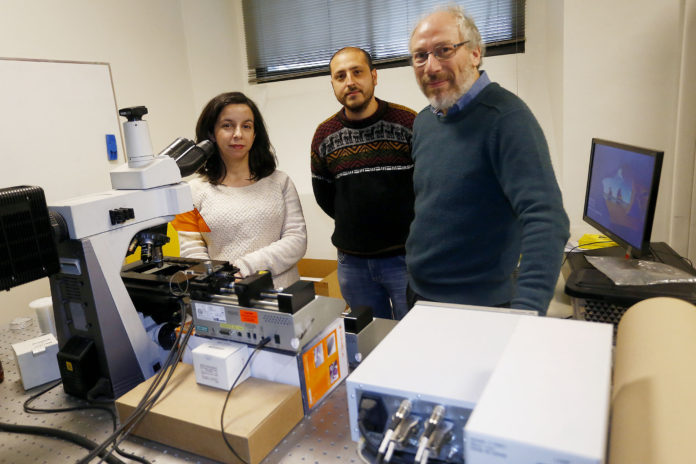Soft Matter journal January’s edition published the investigation of Gabriel Ramos, María Luisa Cordero, and Rodrigo Soto in which they accomplished to create drops propelled by bacteria and the explanation for this self-propelled system.
It is often thought bacteria and microorganisms as immobile and static beings. But they are not. They move variously due to their flagella. When a bacterium is alone it moves in straight line o guided by stimuli. However, when there are hundreds or thousands of them (bacterial suspensions), they gather and move all together as if they were a single organism.
In the Millennium Nucleus Physics of Active Matter, they have been studying these movements for months. The research, led by Doctor Gabriel Ramos together with María Luisa Cordero, Alternate Director of the Millennium Nucleus and Rodrigo Soto, Director of the same, shows how they confined thousands of Escherichia coli bacteria within water micro drops, which were placed on glass plates and surrounded by oil.
What they create were water micro drops propelled by bacteria, which means, they made bacteria to move the drops in which they were inserted. “We showed these drops moved in a persistent random walk at an average velocity of a few microns per second,” says the authors in the January edition of the Soft Matter journal in an extended review of this investigation.
In the end, what Chilean physicists created is what in science is called “biological motor”, and nowadays, is in the middle of the investigations because of the expected effects on fields like electronics (gear movements), environment (transport of micro-cleaners that removes contaminants) and medicine (medications straight to the affected organs).
To accomplish this “biological motor”, they had to first, understand how bacteria moved. For this, the physicists performed many experiments, varying both: the number of bacteria inside the drops as well as the size of the drops. “We also proposed an explanation for the propulsion mechanism. In other words, how bacteria become able to move the water drop, and the key is in the glass presence. Bacteria swimming at the bottom of the drop (near the glass), exert force over a thin layer of oil (between the drop and the glass), and, at the same time, generates a force on the drop and becomes able to move it. As a result of this movement, we have the fact that, if the flow at the bottom of the drop goes in one direction, the drop will move in the opposite direction”, Ramos explains.
Ramos says the importance of this investigation is that it opens a door to other drop transportation form, in this particular case, with bacteria. “Besides, using bacteria, the movement of the drop could be conducted by chemical attractants and repellents. An Investigation that remains pending, but if it is achieved, we could be able to transport components within the drop, or transport just the bacteria to a specific place to produce some kind of component, like proteins or enzymes. This could be useful in medical treatments o chemical processes”, he said.
See the paper here:
https://pubs.rsc.org/en/content/articlelanding/2020/sm/c9sm01839e/unauth#!divAbstract
See the PDF here:


